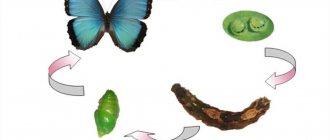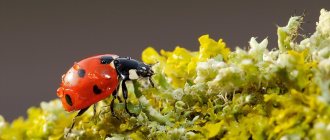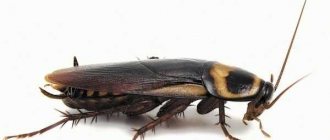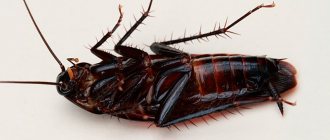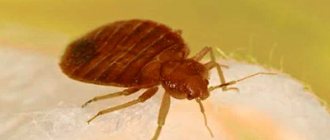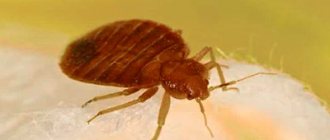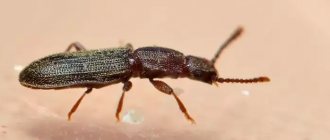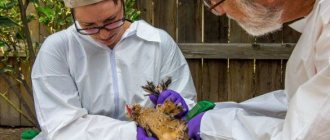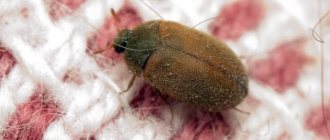- By Vil Malinoshevsky
- About cockroaches
It doesn’t matter whether you are interested in entomology or not, but you should definitely know about cockroaches. All people at least occasionally encounter these insects, and many struggle with them for a long time and not always successfully.
Every day we help people who have been trying to remove cockroaches for months, or even years. And due to the fact that many do not know the key features of the life of these insects, they cannot destroy them. Moreover, people often make mistakes at the very early stage of infestation of a room, when there are single individuals in the room, they allow these single individuals to multiply, and then they can no longer cope with dozens, hundreds, and in some apartments even thousands of cockroaches. Yes, yes, we have seen such premises.
Red cockroaches on the wall behind the stove
Therefore, even if you are not interested in cockroaches at all, you need to know what to do if you encounter these insects in your home. Especially at the first meeting, when it is very easy to kill cockroaches and prevent their mass reproduction. What do you need to know about cockroaches and what do professional exterminators know about them, which allows them to be exterminated in 1-2 hours the first time? And what you don’t need to know about them, what myths about cockroaches need to be thrown out of your head so as not to waste time, effort and money and not give cockroaches a chance to survive and reproduce? Let's figure it out.
Cockroaches can only live next to humans
The most important thing: in Eurasia, cockroaches are insects that can only live next to humans. Insects like them are also called synanthropic. It is human housing, outbuildings, and industrial enterprises that maintain a suitable temperature all year round - these are the only places where cockroaches can survive and constantly reproduce in our climate.
In the tropics, cockroaches can and do live in the wild. Large Madagascar cockroaches, banana cockroaches, car cockroaches live in leaf litter in tropical rainforests, feed on falling fruits and rotting leaves and do not need human proximity.
South American banana cockroach
And the red cockroaches familiar to us have spread throughout the world from India and the Indochina Peninsula. So, at least, scientists think. And there, in warm Southeast Asia, they live safely outside human habitation and outside populated areas in general. And in other warm places on the planet, where they managed to reach with humans, they go out into the wild and survive there due to their omnivorousness and high fertility.
The same goes for black cockroaches.
But in our climate, neither red nor black cockroaches can survive all year round outside constantly heated human buildings.
It is important to understand this so as not to try to scare away cockroaches or drive them away from your apartment or home. Such repelling is ineffective, if not to say that it is ineffective at all. It is almost impossible to scare them away or drive them away, except for a while, because they cannot live anywhere except yours or a neighbor’s house.
Such attempts to scare off cockroaches are similar in their prospects to attempts to scare yourself away from your home. Imagine that in your house someone plugs an ultrasonic repeller into the socket, or lays out tansy, or sprays vinegar on the baseboards so that you “forever” leave your only home. Obviously, you won’t leave your home after this. And the cockroaches won't leave either. Moreover, they are able to exist safely in conditions in which a person would be very uncomfortable.
General characteristics of domestic cockroaches
All representatives of cockroaches have an elongated, flattened, oval-shaped body. Sizes vary from 1 to 10 cm (and more). There are tergites (segments) on the body - up to 10 in the male, up to 7 in the female. The wings are transparent, with membranes, hidden under dense elytra. Many species fly. The legs are adapted for fast running, with spikes. The ovipositor is hidden in females.
The flat head is heart-shaped, with a protective plate from the back. Long antennae with bristles. The jaws are powerful, with sharp chitinous teeth. The eyes are large and atrophied in wingless representatives.
Almost all species of this unpleasant insect love comfortable conditions in the form of warm and humid places, prefer night life, and during the day they hide under stones, leaves, bark and in similar hiding places in human habitation. At night they climb and fly into bright light.
They are considered extremely hardy. They are not afraid of hunger or radiation, and almost immediately develop resistance to most poisons. Can withstand radiation levels 15 times higher than humans (safe levels of radiation will depend on developmental stage).
They can go without food for up to 4 weeks, but are practically omnivorous. They love sweets and fatty foods, but with their mega jaws they grind everything from leather, books, wood to feces and any waste. They enjoy eating plants, fruits and vegetables. Males eat up to 30 g per day, while females can eat up to 50 g.
Cockroaches are very unpretentious
All cockroaches need to live is an air temperature in the range of 20 to 35°C, the presence of food and the availability of water. Moreover, they are extremely unpretentious when it comes to the quality of food: any organic matter is suitable for their nutrition. Adult cockroaches and older nymphs live happily, grow and reproduce, feeding on bread crumbs, drops of oil on the walls behind the stove, peeling skin from people, even mold fungi in pipes.
Cluster of cockroaches behind the refrigerator
Scientists in their studies kept cockroaches on a diet of glue, and the insects survived safely. They were fed only soap, and they also did not think of dying. For lack of anything else, cockroaches happily gnaw paper and soft wood, and symbiotic bacteria in their intestines convert this cellulose into a source of energy and essential carbohydrates.
In addition, it has been shown that the first instar larvae of cockroaches can live for a long time, feeding only on the excrement of adults. This, by the way, is used in pest control - if you feed an adult cockroach poison with a delayed effect, then part of this poison will then go to the larvae, which do not crawl out at all to where a person can see them. And there, in their shelters, they will die from him. But more on that later.
Now it is important to understand that almost any conditions in which a person can live are suitable for cockroaches. This means that there is practically no point in trying to drive or scare them away from the house. They will not live only where humans will not live. And often they survive safely in places where even humans are unable to live.
For example, sewer pipes and sewer collectors in cities are literally incubators for cockroaches. Especially the black ones, for this reason they were also called sewer, because in the summer they can often be seen crawling out of manholes. Cockroaches multiply in huge numbers in food industry enterprises, in flour and grain storage facilities, if they are not poisoned here. People cannot stay in such rooms for a long time due to the large amount of dust in the air. But it doesn’t scare cockroaches.
Wax moth: chemical composition of tincture
Medicinal infusions prepared on wax moth caterpillars contain many valuable components. Most (approximately 50-60%) of them are amino acids.
Among the amino acids there are:
- Alanin. This substance helps increase the body's protective functions and also improves brain activity.
- Serin. It is necessary for the formation of protein structures.
- Leucine. The substance helps lower blood glucose levels.
- Aspartic acid. This component removes ammonia from the body and helps get rid of depression.
- Proline. Activates the formation of collagen, and thereby slows down the aging process of the skin.
- Valin. It is necessary for the proper functioning of metabolic processes in muscle tissue and the brain.
- Glycine. It has a pronounced sedative effect. It relieves anxiety and fear.
The larvae of an inconspicuous-looking butterfly are also rich in minerals, especially potassium and phosphorus compounds. They are also rich in copper and manganese. The extract contains a large amount of carbohydrates.
Cockroaches can eat almost anything that contains carbohydrates, fats or proteins
It is the ability of cockroaches to feed on any organic food that allows them to survive in almost any room. That is, in fact, even the presence of normal “human” food is not a necessary condition for them to live in a particular room. If somewhere there is no such human food, but there is water and a normal temperature is maintained, cockroaches will most likely be able to live there.
So they live in the same sewers, where a person is unlikely to find something tasty for himself. So they live in attics, in the holds of ships, where in the most difficult times they can gnaw each other’s wings from hunger, and according to some evidence, they even gnaw the dry skin on the heels of sleeping people. Similar stories are known, although their authenticity has not been confirmed.
This means that if you put all the food in your house in containers inaccessible to cockroaches, this does not guarantee that you will get cockroaches. Although, the likelihood of their appearance and mass reproduction will be lower - they will prefer to live where there is plenty of food.
We had a case of a call to the post office, where cockroaches lived in the warehouse. There were no products there at all. Only boxes, parcels and envelopes. And among all this, cockroaches roam around. Simply because there is a bakery behind the wall. It would seem, why don’t they live only in the bakery, but climb into the warehouse without food and water? But this is already a strategy for the survival of the species.
So be prepared: if your neighbors often leave fried potatoes or half-eaten bread on the table, and even more so do not close the trash can, then cockroaches may appear on yours, even if there is not a single random crumb anywhere in your apartment.
But cockroaches need water much more urgently.
In rooms where there is no water at all, there are either no cockroaches at all, or they live here if they can quickly get into neighboring buildings for a watering hole.
Natural enemies of the Colorado potato beetle
Colorado potato beetles have few natural enemies. Pheasants, turkeys, and guinea fowl prefer to eat beetle larvae. The eggs and young larvae are eaten by ladybugs. Turkeys and guinea fowl can eat adult insects, but only if they are taught this from a young age by adding crushed beetles to the food.
Natural enemies are hoverflies (small motley-colored flies) and some stink bugs (from the clora family). But tahins (moths) showed the most effectiveness.
Cockroaches definitely need water
Cockroaches cannot live without water. They need it at least in some form. Whether it be drops in the sink, water in the toilet, condensation on the window, damp dust in a dark damp corner, even the flow of sewage in the sewer - this is enough for them. But if somewhere there is no water at all, cockroaches do not appear there, or disappear from there immediately after appearing.
Sometimes they try to use this need for water to remove cockroaches. But in practice, it is almost impossible to “dehydrate” an apartment. There will definitely be water left somewhere. Cockroaches can climb into the pipe in the sink and get to the siphon, which always contains water - it here prevents the smell from the sewer riser from escaping from the sink. They can also drink from coffee or tea cups in the trash can, or from a flower pot. This means that it is unlikely to be possible to get rid of them by depriving them of a source of water. Although theoretically it is possible.
Male black cockroach licks condensation from the wall
For example, cockroaches do not live in silos where grain is stored, although there is a huge amount of husks and crushed grains on which cockroaches can feed. The fact is that it is this husk that absorbs all the moisture that may be in such a tower, and there is simply nothing left for the cockroaches here. But next to such storage facilities - in their annexes, in toilets, in basements - there are sometimes thousands of cockroaches.
Control of the Colorado potato beetle with biological preparations
The chemical industry offers the gardener a number of drugs that effectively destroy the pest without causing damage to the environment or accumulating in the plant. Biological preparations are made from various microorganisms (fungi), they have a paralyzing effect on the pest, causing it to soon die.
To combat the Colorado potato beetle, use:
- Fitoverm;
- Boverin;
- Agravertine;
- Bitoxibacillin.
The drugs are dissolved in water in the dosage according to the instructions, and the plants are treated. The working solution cannot be stored, as it loses its effectiveness in the light.
Cockroaches almost always get into new, not yet infected premises themselves.
Moreover, if they can get here, they will do it.
For example, if they live with your neighbors and can get into your apartment through an open window or through the ventilation, they will get into your apartment. Whether they will then stay here and live permanently depends on whether they find suitable conditions here. Most likely, they will find it and live. But even if they don’t find them, they will definitely check your home or other premises for suitability for their cockroach life.
Sometimes people bring cockroaches into some premises themselves. For example, cockroaches usually arrive in all supermarkets, canteens, and restaurants in boxes with imported products. And no matter how carefully they are hunted down here, sooner or later these guys will arrive again with a new delivery in some box.
This is how, by the way, cockroaches spread throughout the world. Red cockroaches conquered America, Europe and Africa; American cockroaches, on the contrary, migrated with bananas across the ocean and now breed in basements throughout southern Europe and are found even in Ukraine.
However, cockroaches most often get into apartments and private houses from their neighbors. This is not difficult for them - they run quickly, in the warm season they can live on the street and move between houses, and sometimes even breed in the fields. And they always start up simply because they can get into a new room - there are no special reasons for their appearance.
And this is very important: if you know that in residential areas cockroaches come from neighbors and come here on their own, it means that there are some holes, cracks, openings in the apartment through which these insects can get here. This seems obvious, but this leads to a critically important conclusion: if cockroaches once got into you through such passages, then they will be able to get in again in the future. And if such passages are not blocked - sealed, sealed, siliconed, covered with a net - then even after complete destruction they will sooner or later be able to appear here again. This means that even ideal professional treatment in such a room will provide only a temporary effect. We'll come back to this a little later.
Danger of cockroaches
In addition to their frightening appearance, these insects are dangerous because, while moving and absorbing waste and excrement, they carry worm eggs on their bodies, and are carriers of many infectious diseases.
Moving from garbage to food products, cockroaches carry most intestinal infections, especially dysentery, gastroenteritis and diarrhea. Constant shedding provokes allergies to chitin and dust. There are known cases when longhorned beetles climbed into the ears of sleeping people, and also gnawed the skin on the eyelids and ears.
Cockroaches are not dangerous to people
The most common fear associated with cockroaches is the alleged transfer of infections from waste accumulation areas to residential premises. People see how cockroaches run across tables, over food, climb into bread bins, and immediately imagine in vivid colors that just a couple of hours ago this same cockroach could be crawling in a garbage chute, or swarming in the sewer, and now it is trampling bread with these same paws . And he probably picks up various bacteria and viruses in the sewer by the handful, and in a clean kitchen he throws them into the bread...
A cockroach on the handle of a knife - a couple of hours ago it could have been rummaging through the trash can
This is nothing more than speculation. Those cockroaches that live in the apartment run along the walls and floors in the apartment. And, for example, your child, who touches the floor and walls in the apartment with his hands, himself collects in his hands the same garbage that cockroaches can carry onto food or dishes. That is, the cockroaches already living in the apartment do not pollute it with anything new.
Yes, cockroaches can really be swarming in the garbage disposal now, and an hour later they can already be running around your table. But this rarely happens. Single individuals can never move so far. Basically, all these pests move within just one room. Those cockroaches that get into an apartment will clean their legs and antennae many times before climbing onto food, and they will almost certainly not leave sewer or garbage microflora on the food.
Be that as it may, there is not a single case known in which it would be reliably established that a person became infected with any infection that was brought into the room by cockroaches. Cockroaches do not carry any specific human diseases and do not infect people with them.
But what makes cockroaches really dangerous is the allergens they leave in the apartment. Their chitinous shells contain several very aggressive allergens to which many allergy sufferers react. It is believed that a significant part of allergic rhinitis of unknown etiology in people, especially young children, occurs precisely because of an allergy to the shed chitinous covers of cockroach nymphs or to the remains of dead insects. These shells are destroyed over time, their particles fall into dust, are inhaled by humans and cause an allergic runny nose. And if you do not find out that the cause of this runny nose is cockroaches, then after it becomes chronic, it can become complicated and provoke bronchial asthma.
Remains of chitinous coverings of red cockroaches found in the apartment
Similarly, by the way, the remains of cockroaches, which are ground with cocoa beans on plantations and factories in tropical countries, then end up in chocolate and also cause allergies, only this time food allergies, with hives, dermatitis and other troubles. Moreover, scientists believe that almost half of cases of chocolate allergy are actually an allergy not to chocolate, but to particles from the bodies of cockroaches ground together with cocoa beans.
According to sanitary standards, 100 grams of a natural chocolate product - in the same bar, or in candies - can contain up to 60 particles of cockroaches’ bodies visible under a microscope. And this is not considered an excess or any violation of sanitary standards. Moreover, such surprises are equally contained in both simple cheap chocolate and elite bars. Ironically, the less chocolate there is in a chocolate product, the fewer cockroaches there are.
So the main danger of cockroaches is allergies to them.
Boric acid against cockroaches is the best remedy available.
Boric acid is a very good and effective remedy in the fight against cockroaches. Today it has thousands of positive reviews and is relevant, despite the fact that many other drugs are offered on the market to combat these insects.
Its advantages are that it:
- It is a folk remedy.
- Really effective.
- Destroys domestic cockroaches. To date, there are no species that are resistant to it.
- Besides, it's not expensive. In most pharmacies you can buy it for pennies. Especially in powder form.
- Safe enough. Previously, it was used as an antiseptic for treating human skin. If it is not deliberately eaten, then it does not pose a threat to health.
- A huge number of professional and household preparations have been produced on its basis.
When using boric acid as a poison for cockroaches, the main thing is to ensure that the bait is not accessible to children and pets.
However, it should not be considered as the only universal, most reliable remedy for cockroaches. Baits made on the basis of boric acid must be used, but certain nuances must be taken into account.
Boric acid for cockroaches - examples of recipes.
First of all, boric acid acts only when it enters the digestive tract of an insect. It leads to water imbalance. In order for a cockroach to die, it must eat it. Accordingly, he must be forced to eat this bait, which contains acid.
A special recipe is used for this. Balls are prepared with the addition of various bait products. Usually the most affordable products are used. For example, take a few spoons of mashed potatoes. A packet of boric acid is added to it. Mix well. And they roll balls out of the bait.
Or they prepare bait with an egg. Separate the yolk from a hard-boiled chicken egg. Mix with a tablespoon of vegetable oil and the contents of four sachets of boric acid. Dough is prepared from this and balls are rolled. These balls are placed in those places where cockroaches are most often found. They eat the decomposed bait and die.
As bait you can use applesauce, dough, porridge, or add flour.
There are a great many such cooking recipes. They are all based on the same mechanism. Moreover, proportions do not matter much.
All this will work, but it is important to understand that, firstly, they must find these balls, and secondly, they must give preference to them over other products that are in your kitchen. That is, cockroaches do not always eat these balls, or they do not always eat only them.
Therefore, to effectively use boric acid you need to:
- hide all products;
- close all bowls, all boxes, all jars in which food is freely available, so that cockroaches can only eat boric acid baits;
- shut off all free access to water. Because a cockroach, having eaten bait, in simple terms, can simply get to a source of water and “drink.” He will drink a lot, a lot of water, as a result of which the acid will be removed from his body, and he will survive. Therefore, all sources of water must be removed. Before turning off the light, you need to wipe the sink dry, cover the aquarium with a cover glass, and remove all bottles, mugs, and jars.
This method is suitable if you have few cockroaches in your home.
What if there are hundreds or thousands of them? They will eat the bait and even die. But you will not be able to completely destroy them. Because you need to make sure that new insects do not enter the house while boric acid bait is being used. That is, you need to find and isolate all ways for cockroaches to enter the apartment. It is important to block them and only then begin to destroy insects.
You shouldn't expect an immediate effect. If you place bait today, you shouldn’t expect that tomorrow you will completely get rid of cockroaches. This may take from 2 weeks to a month. In addition, if there are a lot of cockroaches, they will multiply faster than get poisoned. In the most advanced cases, if you have both Prussians and red cockroaches, then bait with boric acid can be used as an additional remedy along with gel sprays and other stronger drugs.
Watch the video: what cockroaches are afraid of and how to get rid of them (5:33 min)
The use of boric acid against cockroaches - review.
There are many cases of successful use of bait made on the basis of boric acid. An employee of the Magnit store spoke about one of them:
“Cockroaches have been spotted here before. But we didn't pay much attention to it until their numbers became alarming. They were everywhere. We have tried all sorts of medications to get rid of these insects. After all, we have products. And buyers have already begun to look around. By chance, one of the workers said that friends got rid of pests at home using a folk remedy. We bought several sachets at a nearby pharmacy. We decided to try it. And lo and behold! The cockroaches really disappeared. We thought that this was again a short-term effect, but we still don’t have them to this day. Although we periodically place baits in the warehouse. Otherwise, unexpected guests will suddenly arrive again with goods!”
Are cockroaches dangerous for people?
Cockroaches are of little danger to people. Is it true? Common known fears are associated not so much with their unpleasant appearance, but with the fear of contracting some disease from them. Many people with a good imagination see how these insects climb through sewers and trash cans, and then crawl onto the table, into bread bins, into cabinets with food and dishes. After all, they probably pick up tons of bacteria with their paws in the sewer, and then bring them into the house. In fact, this is nothing more than speculation. Although theoretically this is possible. Because individuals living in a private house or apartment, as a rule, rarely leave the confines of the room where they currently live. This is confirmed by numerous studies.
Cockroaches don't bite people
Even the largest representatives of cockroaches are harmless. For example, giant Madagascar cockroaches hiss when frightened and hope to scare away the offender, but they almost never use their jaws.
Moreover, Prussians and black cockroaches do not bite people.
These games with cockroaches are completely safe
There is an opinion that with a very large number of cockroaches in the room and a complete absence of food here, these insects can gnaw the skin of a sleeping person. There is even allegedly evidence that on ships in ancient times, cockroaches gnawed off the skin of people's fingers.
In fact, today in no residential building can a situation arise in which cockroaches become so hungry that they begin to bite people. They can go from any room to where there is normal food that is safe for them. And there is always enough food for them in human housing.
As a rule, people want to consider bumps on their bodies to be cockroach bites when they convince themselves to the last minute that there are no bedbugs in their house. Some people are terrified of bedbugs, others cannot admit to themselves or their relatives that bedbugs live in the house, and they come up with any explanation for the bumps on their skin - including trying to explain to themselves that they are being bitten by cockroaches.
In fact, there is no documented case in which it would be reliably confirmed that a person was bitten by a red or black cockroach. If you can photograph something like this, please send us such confirmation. It is very interesting.
Plus, in such quantities that cockroaches in housing are critically short of food, they do not accumulate here. When there are a lot of them, some of them spread out into neighboring rooms and their number in the apartment never exceeds a certain threshold. Although…
Why are cockroaches harmful to humans?
People often react to the appearance of cockroaches in the house without due concern. These insects, although not parasites, create the illusion of safety. And sometimes good signs or omens are even associated with their invasion.
Cockroaches are a sign of social ill-being, poverty and hopelessness
Many people try to get rid of uninvited guests, mainly due to disgust. But these insects are more dangerous than they might seem at first glance. Cockroaches living in an apartment are not limited to its boundaries: they travel throughout the entire house, including basements, garbage chutes and sewers. Sewage and excrement reliably cling to the chitinous shell. And when the cockroach returns to its native kitchen, it brings there everything that it managed to collect, including helminth eggs and pathogenic microbes.
A cockroach crawling on food leaves pathogenic microorganisms on it that can cause serious harm to human health.
Products on which a cockroach has crawled should not be eaten. This is dangerous to your health.
Diseases carried by cockroaches:
- dysentery;
- bacteriosis;
- salmonellosis;
- meningitis;
- pneumonia;
- genital infections.
Sometimes a person does not even suspect that the cause of his sudden illness is his proximity to cockroaches.
Video: cockroaches are carriers of disease
The waste products of cockroaches themselves are no less dangerous to human health than bacteria brought from outside. The chitinous coverings remaining after molting, the remains of dead insects and dry excrement, combining with house dust and entering the respiratory system, mucous membranes or skin of a person, provoke such serious diseases as allergic conjunctivitis, rhinitis, dermatitis and bronchial asthma.
But that's not all. Did you know that cockroaches can bite humans? No, they do not attack like mosquitoes or bedbugs and do not feed on blood, but they like to gnaw off pieces of skin from sleeping people. They especially like the epithelium of the nasolabial zone, eyelids and earlobes. They will not disdain the skin on their fingers. Against this background, the news that red cockroaches, or cockroaches, as they are sometimes called, feel good inside the human ear, is no longer so impressive. But getting a cockroach into your ear is not at all easy. And often this requires medical assistance.
Cockroaches are very reluctant to leave the human ear
In scientific circles, there is a special term - “blattopterosis”, which covers the entire range of troubles that cockroaches can cause to human health.
Cockroaches reproduce very quickly
This is especially true for red cockroaches. This is the key to their survival and the reason why they are so difficult to fight.
An adult cockroach lives for about six months to a year. During this time, the female manages to bear and lay from four to eight oothecae with eggs. Such a capsule with eggs, when seen on a cockroach, is sometimes mistakenly considered one egg. From each such ootheca emerge from 8 to 56 nymphs, which over the next 50-60 days molt 7 times and turn into adult cockroaches. That is, already two months later, these small cockroaches themselves will reach the age when they begin to reproduce.
By the way, immediately after molting, each cockroach remains white for several hours. These are not albinos, as is sometimes mistakenly believed. These are just nymphs with body coverings that have not yet hardened...
At the same time, cockroaches do not have any natural enemies in the apartment - no one eats them here on purpose, and even if some domestic animal does this, it eats insects only occasionally, just when they meet. The general population of insects in the apartment does not suffer from this.
As a result, the number of cockroaches in an apartment, under conditions suitable for them, grows very quickly, one might even say rapidly. Consequently, even minor delays in their destruction, including attempts to try to remove them using unreliable means on the principle of “maybe it will help,” end in hundreds of cockroaches behind the refrigerator and shock for the owners, to whom the exterminator shows such nests.
For example, watch the video from the processing, where the master discovers many hundreds of cockroaches in the apartment:
In red cockroaches, this ability to reproduce quickly is especially noticeable due to their peculiar care for their offspring.
Do cockroaches bite?
Cockroaches are, in principle, capable of biting a person. But in reality they almost never bite. The bite is an exceptional rarity. It is associated with extremely high contamination of the premises and lack of food. If a person wakes up in the morning and finds some bites on himself, then first of all you need to check whether bedbugs, fleas, or mosquitoes have bitten you.
The chances of you being bitten by a cockroach are negligible. By their nature, cockroaches are quite peaceful insects. They eat almost any organic food. They play the role of recyclers. They can chew anything: paper, food. But their jaws are completely unsuited for puncturing the skin like bedbugs or mosquitoes. Or for its dissection, as, for example, in blood-sucking flies. Or for biting like some ants. In addition, cockroaches do not have any stinging devices, like those found in wasps and bees.
Simply put, cockroaches don't have the equipment to bite people. Even if you pick up a cockroach, it will not bite you. They do not have the reflex to bite for defense.
And, nevertheless, there is reason to believe that domestic cockroaches can still bite. They can bite the upper layers of the epidermis on the heels and feed on debris under human nails. It has more to do with hunger alone. If these insects have absolutely nothing to eat, then there may be a danger of being bitten.
But you are unlikely to know such eyewitnesses among your friends. And most likely the culprits of the bites will be other insects.
Prussians protect their eggs
Not so directly that they protect them and drive predators away from them. Their care is different: females carry oothecae with eggs at the end of the abdomen almost until the very moment when the larvae hatch from the eggs. Thus, the eggs, which could be eaten by any predator or even another cockroach, are always with the female, who can escape in case of danger. And the larvae emerging from these eggs themselves hide quite effectively.
Ootheca of the red cockroach shortly before the larvae hatch
Due to this, by the way, red cockroaches displace black ones in those places where these species are found together.
The fact is that female black cockroaches lay ootheca a few days after the entire capsule has formed, and for several more weeks such ootheca simply lies where the mother left it until the nymphs hatch from the eggs. If red cockroaches find this capsule, they happily eat it. Thus, in those places where red and black cockroaches live next to each other, the red ones completely destroy the new generation of black ones, and the more Russians appear here, the less chance the eggs of black cockroaches have to survive.
For this reason, the black cockroach, although it remains a widespread species, is much less common than the red one.
Interestingly, the same feature that ensures the high survival rate of red cockroach eggs also makes it easier to control.
There are almost never any eggs of red cockroaches in the room, which means that after good disinsection, nymphs should not appear here.
This feature is especially clearly visible when comparing the baiting of cockroaches with the baiting of bedbugs. Bedbugs often have to be poisoned twice because after the first treatment, eggs remain in the room, which are not affected by insecticides. As a result, when baited, adult bedbugs and larvae die, but new larvae hatch from the eggs after a few days. They grow, begin to bite people and need to be re-poisoned before they reach maturity.
Red cockroaches do not have eggs indoors. Such eggs are either carried by the female, or after laying, larvae hatch from them within a few hours. The probability that at the very moment of treatment one of the females will lay such a capsule and nymphs will emerge from it at that very moment is minimal. Even if this happens, all newly hatched nymphs will immediately come into contact with the product that has not yet dried and die. This means that in one treatment you can destroy all the cockroaches in the apartment. Moreover...
Types of domestic cockroaches, harmful and exotic (bred), their characteristics
More than 4,500 species are now known, of which only 55 species are found in the CIS. And apartments are inhabited by only 3 species: red (Prussian), black and American.
Red cockroaches
Prusaks, or red cockroaches, can fly, but not for long. Adults come in different colors and are up to 1.6 cm long. They live in colonies. Life expectancy is about 6 months from the moment of hatching. They practically never meet without a person.
Males are oblong, wings peek out from under the elytra. Can fly short distances. Females are more rounded, without clearly defined wings. At one time, up to 40 eggs are laid in a capsule, which is worn for 2-4 weeks until the nymphs emerge from it. Nymphs are darker than adults and have no wings. After 2 months and 6 molts, the nymph turns into an adult.
After molting, the cockroach is much lighter, translucent, but this passes quickly, after 1-2 days they darken. Adults live up to 4 months. Over the course of her entire life, the female makes 4-9 clutches in the ootheca, that is, up to 400 eggs from one individual in just six months.
Their homeland is southern Asia, so they cannot tolerate cold at all, so when cooled to -5°C they die, and they feel so good in human habitation. The Prusak is omnivorous; in case of hunger strike, it can even chew soap or plaster. Does not tolerate thirst well.
Black beetle
They are much less common than redheads. They, unlike the Prussians, can live both among people and in the wild, not far from human habitation. They prefer warm, damp places (sewers, mines). The size of an adult cockroach reaches 8 cm. Representatives of this species run fast, but cannot fly.
American cockroach
Large (up to 5 cm), with a red-brown shell. Capable of running up to 75 cm/sec, while changing directions of movement up to 25 times. It flies, but rarely. It is impossible to catch with your hands. They have a powerful mouthparts (they chew through pieces of wood and plastic) and eat everything, even hair and shoes.
Very thermophilic - they die in minimal frost. They live in huge colonies (tens of thousands of individuals).
During mating games, the male runs around the female and flaps his wings. This is due to the pheromones secreted by the lady. After fertilization, the pregnant female first carries a capsule with eggs (up to 2 days), after which she buries the ootheca into the substrate. BUT! The female can lay eggs without fertilization by the male.
Furniture cockroach
Officially recorded only 100 years ago. Similar to Prussians, but smaller (up to 1.2 cm). The body shape and shade may vary, but the main feature is 2 stripes along the body. The color of these pests ranges from bright brown with a red tint to almost black. They run and jump very fast.
They tolerate a lack of water more easily than other species; they love starchy food (any paper, paste). The optimal temperature is about 30°C and high humidity.
Vietnamese (Turkestan) cockroaches
They live in houses, in landfills, and in the wild. Yellow, with a dark brown tint. An important feature of this species is jumping and flying. They consume plant remains and debris from human activities.
Egyptian cockroaches
These pests live in Asia, in the Caucasus and Crimean mountains. The brown color and rounded body shape make this species look like a turtle. Males are winged, females are not. Large (up to 4.5 cm), they live on farms, in houses, and animal burrows. They eat all types of organic waste, including excrement. They can starve for more than 3 months, but the lack of water is critical for them.
At one time, the female lays up to 18 eggs; in total, she can lay up to 5 ovipositions during her life. It takes 2 years from birth to adulthood, during which time it sheds several times. The adult stage lasts another 2 years.
The harm from this type of cockroach is enormous, since after eating the insects, the animals become infected with paratyphoid.
Madagascar cockroach
Giant individuals (up to 10 cm) are known for their hissing. This is how they try to scare the enemy. Unpretentious, omnivorous. These are viviparous insects. They prefer humidity and warmth, like representatives of other species of the cockroach family. They are bred as pets or as food for snakes and lizards.
Rhino cockroach
A large beetle up to 8 cm and weighing about 35 g (only 2 times lighter than a sparrow). Chocolate color. A good digger, excellent at digging tunnels. It is massive (40 g). Consumes parts of plants, but will not refuse particles of dead animals.
Rhinoceroses are clean and do not smell. They do not fly and cannot crawl on glass, so they are excellent for keeping in aquariums.
Chess cockroach
Representatives of this species stand out among their relatives with their beautiful checkerboard colors. Found in India. They grow up to 3 cm. They love warmth and moisture (above 70%), prefer night walks.
banana cockroach
It has an unusual green color. Can fly. Prefers to live on banana plantations, consuming parts of plants and fruits.
Forest cockroach
An inconspicuous inhabitant of wooded areas (up to 11 mm), eats everything it finds (all kinds of greenery, carrion). During the day it hides under the grass or in the roots of bushes and trees. Translucent body of brown-golden color. There is a black spot on the head, the wings extend behind the body. It is not very dangerous for humans, as it cannot even bite through the skin of a finger.
Little car
They got their name thanks to two spots on their head that look like car headlights. They reach 5 cm and prefer not to be seen by people. They grow slowly, love mating games and competition for the female. They don’t fly or crawl on glass, so they often join the ranks of pets.
Dead Head
This large insect (up to 5.5 cm) received its name due to its frightening colors. It eats small insects, and if there is a lack of food, it will not disdain its relatives.
Marbled (ash) cockroach
It comes from Africa, but is found in most countries, as it is very undemanding to conditions and food, and reproduces well. It is also called naufet. The insect reaches 3 cm.
It feeds on raw vegetables, fruits, various grains, flour products, and does not disdain paper and thin plastic. They can eat each other when there is a lack of food. Often grown to feed reptiles and large spiders.
Sarawak cockroach
The difference between this species and others is the ability of the larvae to swim well. They prefer to live close to sources of moisture; in case of danger, they can dive to the bottom and hide there. Otherwise, their habits are like those of other relatives.
Megalobat cockroach
This longhorned beetle is hard to miss - Megaloblatta longipennis is considered the largest representative (9.7 cm by 4.5 cm in width). And its close relative (Megaloblatta blaberoides) has the largest wingspan (18.5 cm).
Lapland cockroach
Brown-brown, with a black dot, reminiscent of dry leaves. Found in Europe and America. Reaches a length of 1.4 cm. Fast, not demanding.
Asiatic
Found in areas with a tropical climate. The closest relative of the Prussian. Prefers to live outside, hiding under a layer of leaves. The population increases in the warm season and decreases in the fall.
Blaberus cockroaches
Large and colorful Blaberus giganteus hides well among foliage and grass. Found in various parts of America. They grow up to 9 cm in length.
Cockroaches die from most insecticides
We have already tested more than 40 drugs based on various insecticides. In the form of an aerosol, almost any means kills red and black cockroaches.
So, in our experiments, cockroaches from different apartments and from different industrial enterprises were successfully killed:
- Get Total and Get Express
- Executioner
- Chalk Mashenka (!)
- Boric acid and borax
- Karbofos
- Cifox
- Combat
- Sinuzan
- Averfos
- Lambda Zone
- Various aerosols from the Raid and Raptor lines
- Hector from cockroaches
It was not possible to kill the cockroaches with Phenaxin powder, permethrin-based smoke bombs and several gels. We believe that the point here is not so much in the active substance, but in the preparative form of the products themselves. For example, an aerosol with fipronil quickly killed cockroaches that had not previously been “taken” by a gel based on the same fipronil.
In any case, cockroaches indoors can be completely exterminated at one time with a relatively inexpensive means. If this fails, it means that the product is being used incorrectly. If you manage to destroy cockroaches, but then they appear again, it means that the places where they enter the room are simply not blocked.
We have completely removed cockroaches from apartments many times. In one heavily infested apartment, we even shot two videos: one before treatment, so that you could assess the degree of infection and look at the procedure for disinfestation itself, and the second, three weeks after the persecution, when not a single live cockroach could be found in the apartment.
In most cases, DezinCity specialists poison cockroaches with exactly this result; in the most difficult situations, after the second treatment, not a single cockroach remains in the apartment. And the exterminator always warns the customer that if cockroaches once got into the apartment, then in the future they will be able to do this again and will probably do so. People nod their heads in understanding, promise to find and block all ways for cockroaches to enter the apartment, but forget about this exactly at the moment when the exterminator leaves the apartment. But they remember after a couple of weeks, when they notice new newcomers. That is, when it is too late to eliminate the routes of their penetration.
Reasons for the appearance of cockroaches in an apartment
The most common case of cockroaches entering an apartment is migration from neighbors. Having a relatively small size (the length of red cockroaches does not exceed 1.5 cm), they are very mobile and are amazingly able to crawl through any holes and cracks, be it a crack in the wall or a ventilation duct.
Sometimes cockroaches are brought into an apartment with things that were previously in places where there was a large concentration of insects. For example, having visited an infected premises and stayed there for some time, you may not notice how an individual pest crawled into a bag, and after some time ended up in your apartment.
Reasons for cockroach migration
Living with neighbors, cockroaches can avoid your clean apartment for years. But there are reasons that will force them to come visit:
- population size. Even such small insects may find themselves cramped inside one apartment if there are a lot of them;
- lack of water or food, for example, if neighbors have left the apartment for a long time;
- pest control work or repairs from neighbors. In this case, the cockroaches are fleeing and your apartment may be in their path as a safer option;
Video: massive invasion of cockroaches
Favorable conditions for insects
Cockroaches can appear in any apartment. But in order for them to actively reproduce and feel comfortable, it is necessary to create special conditions. Namely:
- access to water. Without moisture, insects live for 7–10 days, and even then only half-life. But places with high humidity (near leaking taps, condensation on pipes, puddles on a table or floor) will be most favorable;
- Cockroaches can survive without food for much longer (a little over a month), but it is also necessary. Therefore, cockroaches will like leftover food and crumbs on the table.
In other words, by creating unsanitary conditions in the apartment, you can be sure that guests will not pass by.
What do cockroaches look like?
There are more than 4.5 thousand species of cockroaches in nature. In the territories of the post-Soviet space, there are only two synanthropic species (living in human dwellings): red and black. They got their names from the color of their chitinous shell. Black ones are larger than red ones and can reach a length of up to 3 cm.
The black cockroach looks especially sinister
Adults have an oval-shaped body, soft and thin wings, three pairs of legs covered with spines, and a flat, triangular-shaped head with strong downward-facing jaws. The feature that distinguishes cockroaches from all other insects is their sensitive antennae, which are sometimes larger than the length of the body.
The red cockroach is an insect with long, moving whiskers.
Cockroach larvae look like smaller versions of adults. The first few days after leaving the egg capsule they are white and almost transparent. Then they acquire characteristic pigmentation.
Larvae emerging from the egg capsule
Video: cockroach under a microscope
Signs of cockroaches
One or two cockroaches behave very modestly and their presence may not be noticed. Only as the population grows do traces of their presence become obvious:
- oothecae or egg capsules from which a new generation of cockroaches emerge. In individuals of the black species, it has a dark brown color and a length of 1.2 cm. The Prussian ootheca is shorter - only 8 mm, red in color with clear transverse stripes;
- insect excrement, which can be found inside cabinets, on shelves, dishes and even wallpaper. They look like small black dots, similar to ordinary garbage or dust.
The female red cockroach carries an ootheca until the larvae fully mature.
Cockroaches are nocturnal, and during the day they prefer to hide in shelters. You can detect them by turning on the kitchen light at night. But if the population is too large, individual individuals can be seen during daylight hours.
Video: how to find out if there are cockroaches in the house
Cockroaches are not afraid of repellers
Neither ultrasonic, nor electromagnetic, nor magnetic resonance. Such repellers are nothing more than dummy toys for those who want to try their luck before a normal pest control and throw away a couple of hundred rubles with the expectation of “what if it helps?” Will not help. Even theoretically, there is no principle according to which a signal from such repellers could scare away cockroaches. But in fact, such repellers are nothing more than a box with a light bulb, for the blinking of which the buyer, in fact, pays money.
Not a single case has been confirmed in which such devices would get rid of cockroaches
At every second treatment, experienced exterminators listen to stories from clients that before calling the service, a person tried to fight cockroaches with repellents, but was unable to completely remove the insects. Moreover, people seriously believe that a certain ultrasonic signal from such a device, plugged into an outlet, is really effective against cockroaches, capable of scaring off and even killing these insects. It’s only a pity that over the years of treatment, specialists have not found a single cockroach that would have suffered from the repeller. But more traditional methods are quite effective. For example…
Fighting cockroaches using traditional methods
If you don’t succeed in choosing an industrial product, you can try to get rid of cockroaches using time-tested folk methods. They are distinguished by their environmental friendliness and safety. And the ingredients for their preparation can be found in the kitchen, at the nearest supermarket or pharmacy.
Ammonia
Being in close proximity to ammonia, cockroaches die almost instantly. But it is not recommended to treat the apartment with a pure product. Being a 10% ammonia solution, ammonia in large quantities is unsafe for health and can cause poisoning of the body. Therefore, to kill cockroaches they use the following method:
- Prepare a solution: for 1 liter of water, 1 tablespoon of ammonia.
- Use the resulting product to treat all surfaces in the house: floors, shelves, cabinets, etc.
- Leave the apartment for a day. And after returning, ventilate the room well and do a wet cleaning.
Ammonia is the worst enemy of cockroaches
To protect the respiratory system during work, it is recommended to use a damp gauze bandage or a special protective mask.
Video: home remedies for cockroaches
Freezing
Cockroaches are heat-loving insects. At temperatures below 10 °C, their activity noticeably decreases, and negative values lead to mass death. This biological feature can be used to get rid of cockroaches in the winter season. When carrying out “frost ventilation” of an apartment, it is important to take into account the time interval.
- cockroaches die within half an hour at a temperature of -5 °C;
- at -10 °C insects will last no more than two minutes.
Boric acid
The most popular folk methods for killing cockroaches are recipes using boric acid. This pharmaceutical product, combined with food, causes dehydration of insects, as a result of which they die within 24 hours.
Recipe with egg and potatoes:
- Combine the egg yolk with the same amount of boiled potatoes.
Egg yolk is a bait that no cockroach can resist - Add 20 grams of dry boric acid and mix well.
You can buy boric acid at any pharmacy. - Make several small balls from the resulting mass.
Balls with boric acid - a portioned treat for pests - Place them in different places where cockroaches live.
DIY traps
An excellent alternative to industrial designs would be a homemade cockroach trap. To make it you will need:
- cardboard or thick paper;
- double sided tape;
- bait.
Procedure:
- Place tape on a sheet of cardboard so that there are no gaps.
Make the base of the trap from cardboard with a square side of 15 or 20 cm - Place a treat in the center of the structure.
The finished product should look like this: - Place the structure in areas where cockroaches gather. The result will not be long in coming.
A humane way to catch cockroaches
The trap can be made from an ordinary plastic bottle:
- Generously coat the top inside of the bottle with vegetable oil.
Vegetable oil will prevent cockroaches from escaping from the trap - Place some delicious food inside.
- Without closing the lid, leave the bottle overnight. Cockroaches, wanting to taste the treat, will definitely find themselves inside. But they won’t be able to get out on the oil-slick plastic.
Do not close the cap on a plastic bottle, otherwise cockroaches will not be able to get into it. - Decide for yourself what to do next with the prisoners. The author of the following video releases them away from his home.
Video: how to get rid of cockroaches peacefully
Cockroaches die quickly at high temperatures and frost
It is known that cockroaches generally cannot tolerate negative temperatures. In this regard, they are even more vulnerable than bedbugs: bedbugs can survive long-term cooling down to -5 - -10°C, and cockroaches die at -5°C within a few hours.
Likewise, both red and black cockroaches die in less than an hour at air temperatures above +45°C.
This means that you can destroy them indoors, for example, using an industrial heat dryer. They warm up the air to 50-55°C, this temperature is maintained for 1.5-2 hours, and there are no live cockroaches left here. Moreover, such a disposal will be completely safe for people and pets - cats and dogs.
Interesting facts about cockroaches
Giants from Madagascar make excellent pets. Bright, large (up to 10 cm), they crack and hiss in a funny way. They are unpretentious and eat everything, even dry bread or fish food. They are also used for running. Often eaten in Asia and South America.
Black pests from this family were used as a folk remedy for kidney diseases, to stop an asthma attack, and to get rid of helminths. Fried cockroaches were given for diarrhea, and tea made from dried longhorned beetles was given for dropsy.
In the old days, it was believed that cockroaches lived only where there was plenty, so they were taken with them to a new home.
Headless barbels die from dehydration, not from their body being decapitated.
Traces of cockroaches were found in layers older than 320 million years.
It's easy to kill cockroaches
And all the problems with exterminating them are related to the fact that it is much more difficult to prevent them from getting into the room again.
It is simply surprising that most people understand this, but do not take any measures to find and block the entry points of cockroaches into the premises.
For example, we regularly communicate by phone with customers of an online store that sells insect repellents. And many quite sensible people tell us that they have poisoned cockroaches many times with various means. These remedies work, the cockroaches disappear, but then appear again. And when we say that in this case there is probably a repeated migration of cockroaches from neighbors, people agree and say that they understand this.
The most amazing thing is that, realizing this, they continue to look for a new super-effective remedy that could both destroy cockroaches and prevent their reappearance. People cannot answer the question of how such a remedy could work to prevent cockroaches from getting into the apartment. Apparently they are hoping for a miracle.
But there is no miracle. The whole secret of exterminating cockroaches is to find, while they are living in the apartment, through which holes and cracks they get in, then seal these routes of entry, and then poison those insects that are already in the apartment. Moreover, such blocking of the “entrance gate” is an inexpensive procedure. Usually it requires a tube of silicone sealant or a can of polyurethane foam, which is enough to seal the cracks and holes found. And during normal renovations in an apartment, there are usually very few such entrance gates - literally two or three small cracks, in the bathroom or kitchen. Why people don’t do this, but prefer to live with cockroaches for years, fight them and look for more and more new means to destroy them, is a big mystery to us.
There is another life hack for those who don’t want to seal cracks and holes...
Popular pest control products
Preparations used for etching
Products of this type are capable of protecting young potatoes only for a certain period of time. After this time comes to an end, chemical decomposition of the insecticide occurs. To prevent the beetles from damaging the plants at the end of this period, it is necessary to treat the area again, but using some other means.
Prestige, KS
Place No. 1 “Prestige, KS” It is a drug with a systemic operating principle. Manufacturer: German chemical concern Bayer. The drug contains the following active substances:
- imidiacloprid ; insect repellent, developed more than ten years ago and having excellent characteristics: protection of tubers treated with it remains effective for one and a half months; in addition to the Colorado potato beetle, the tubers will be protected from cicadas, aphids, and mites; and soil parasites (mole crickets, beetles, wireworms and cutworms) will avoid the area;
- pencikuron ; remedy against fungal infections; the time for protecting potatoes from various forms of fungus is about 40 days; First of all, these diseases include late blight and rhizoctorosis;
The product belongs to the third hazard class. The working concentration for using this product is 1 to 20.
The consumption rates are as follows: 1 ml of the drug is consumed per 1 kg of potatoes. Pre-planting treatment is carried out: the tubers are laid in one layer on a tarpaulin or soil and they are sprayed with a solution prepared earlier. The solution is pink, so you can immediately see how well the tubers are covered with it. When the solution dries, a thin layer of film forms on the tubers.
After the solution has dried, the tubers should be turned over to spray their lower part. Then they should be dried again, and then planting can begin. This is mandatory: plant so that both sides of the potato dry, otherwise the effectiveness of the product will noticeably decrease. It is also recommended to treat potatoes near the planting site so that during transportation the film of insecticide is not removed from the body of the tuber.
Since the product gets into the stem and leaves of the plant, the beetles, starting to feed on them, immediately die, without even having time to lay eggs. into the tubers that are newly formed on the bush and which will later be removed as a harvest . An additional function of the drug is to stimulate the growth of potato bushes and have an anti-stress effect, since the specimens treated with it are much easier to tolerate a decrease in temperature and lack of water. When its validity period expires, the product completely decomposes into non-hazardous components.
“more about the drug” Prestige – https://prestizh-ks.ru/
"Taboo"
Place No. 2 “Taboo” Also a systemic insecticide based on the same drug, imidiacloprid. Similar to the previous drug, it provides comprehensive plant protection not only from the Colorado potato beetle, but also from wireworms and other parasites. The Tabu product can be used in conjunction with fungicides.
The solution is made as follows: 8 ml of the product must be dissolved in a liter of water. This will be quite enough to treat about a hundredweight of potato tubers. This drug contains sticky surfactants that can create a thin and durable film on its surface that holds the insecticide around the tuber. The film is strong enough that it allows tubers to be treated far from the planting site; During transportation, the protection from the tubers will not fall off.
For better visibility of the etched layer, it has a pink color. Since sprouts may be injured when turning over sprouted potatoes, Tabu can be used to treat tubers directly in planting holes. For spraying 100 sq. m area must be diluted in 10 liters of water with 4 ml of the drug. In this case, the solution must be made homogeneous; This can be achieved as follows: first, the product is dissolved in a glass of warm water, and then the resulting glass of highly concentrated product is poured into a 10 liter container.
The tubers are placed in the holes, and then they are sprayed with an average consumption of about 30 ml of product per tuber. The poison permeates the shoots and leaves of the plant, but does not get into the tubers. The duration of the drug is 1.5 months, which, taking into account the life cycle of the Colorado potato beetle, does not allow the latter to have time to lay eggs.
Products for spraying bushes
"Aktara" product
Place No. 3 “Aktara” Also a systemic remedy, but based on the drug thiamethoxam . It has the ability to almost instantly absorb into the foliage and stems of potato bushes, turning them into poison not only for beetles, but also for almost all Lepidoptera.
The action of the drug is based on blocking the nervous system of insects , their death occurs approximately a day after its use; however, insects cannot eat during these days.
Means "CORADO"
Place No. 4 “Corado” Imidiacloprid-based product. Has a systemic effect . Approximately 60-80 minutes after it enters the insect’s body, it makes it impossible for it to feed. Death occurs after about 2-3 days. The drug is not sufficiently moisture resistant, so it is recommended to use it in the absence of wind and precipitation in the evening or in the morning. As a last resort, it is allowed to use the drug before watering (or rain), but no later than 4 hours before it.
The product is packaged in 1 and 5 ml ampoules or 10 ml bottles. Product consumption per 100 sq. m is 1 ml per 10 liters of water. The duration of the product is about 30 days. Potatoes can only be treated with this insecticide once per season.
"Killer"
Place No. 5 “Killer” Contact-intestinal drug based on the compounds chlorpyrifis and cypermethrin . Kills almost all potato pests resistant to phosphorus compounds. It is recommended to use in dry, windless weather at a temperature not exceeding +22°C .
The drug consumption is about 100 ml per 100 sq. m. This volume is dissolved in 10 liters of water. The period of activity of the drug is 3 weeks. Just like other insecticides, it is allowed to treat potatoes only once per season. Moreover, this treatment should not take place later than a month before harvest.
Monument to the beetle. From the “grateful” farmers of Hungary in honor of the 50th anniversary of its appearance in the country
Cockroaches can and should be poisoned by teaming up with neighbors
This is obvious: if cockroaches live with neighbors, then it is from the neighbors that they can migrate to you after destruction. If you team up with your neighbors and poison cockroaches in all neighboring apartments at once, then there will be no re-infestation - the cockroaches simply will have nowhere to come from. Provided, of course, that not a single treated apartment borders an infected premises.
Therefore, re-infestation occurs much less frequently in private houses: they do not border on other premises at all, and in order to infect them, cockroaches must come here through the street, which happens relatively rarely.
Insecticide treatment
To treat plantings, modern pesticides are used, which have a complex effect on pests. They have an intestinal, contact and enteric-contact effect on Colorado potato beetles, completely destroying them. However, the effect of many drugs is limited in time, so such treatments are carried out repeatedly during the season. In addition, insecticide treatment is carried out 3-6 hours before the onset of rains. Otherwise, the effect of application is minimized. Among the frequently used means, gardeners use the following:
- Killer,
- Aktara,
- Spark,
- Mospilan,
- Karbofos,
- FAS,
- Kondifelin,
- Inta-vir and others.
When using chemicals, be sure to carefully read the instructions before use. Use protective equipment and gloves while working. After work, wash your hands and face thoroughly with soap and water.
You can protect your apartment from cockroaches even if the whole house is infested with them.
Very often we hear statements that it is impossible to protect yourself from cockroaches, because they have already crawled throughout the house.
But exterminators, even in infested houses, saw apartments without a single cockroach. And such apartments are not always ideally renovated. True, there are almost always cautious and prudent people who live there, who know that a tube of silicone sealant costs much less than professional pest control or a kit of cockroach killers. In such apartments, the joints between pipes and walls are insulated, the entrance doors are sealed, there are small mesh on the ventilation, and there are no cockroaches. Although literally behind the wall of such an apartment, insects are literally swarming.
The most important thing: to protect your apartment from cockroaches in this way, you do not need to make new repairs here. Pointed, cheap, but correct solutions will be quite enough to completely block cockroaches from accessing your chambers.
Description
The Colorado potato beetle is known to almost all gardeners who grew potatoes, tomatoes, peppers and other types of nightshades on their plots. The insect received this name in honor of the state of Colorado, where it was first discovered as a species in the early 18th century. It was brought to us along with potatoes, but it did not immediately manage to reproduce. Only after the 40s did the massive spread of the Colorado potato beetle begin in Europe and Russia.
The survivability of the Colorado potato beetle is amazing. Summer residents make every effort to destroy it, but the next year, the insect again eats the planted crops. Difficulties in fighting the beetle arise due to the following reasons:
- The beetle is very prolific and reproduces at an amazing rate. Over the summer, the female Colorado potato beetle lays up to 1000 larvae, of which up to 700 adults survive.
- The beetle has suitable living conditions, because on the territory of Europe nothing threatens it except humans, i.e. there are no natural enemies.
- It tolerates cold well, as it burrows deep into the soil during winter hibernation. This also protects it from all sorts of drugs that gardeners use to water the soil.
- It has endurance and the ability to make long flights, making it very difficult to remove it.
- When flying, it can move from city to city, and even from country to country.
Folk remedies
Folk remedies are especially popular because they are not toxic to people and are almost as effective as insecticides. Preventive measures are aimed at preventing the reproduction of the Colorado potato beetle on the site. To do this, the soil must be prepared. Fresh sawdust is placed between the rows, the smell of which repels adult insects and larvae. Another effective remedy is birch ash, which is sprinkled between the rows and young shoots. Birch ash serves as an excellent means of destroying larvae and will help protect the harvest. Also, a solution is prepared from ash powder and dry wormwood, which is sprayed on the leaves.
One of the most common methods is to collect beetles and larvae by hand. But this takes a lot of time and is not very effective, since new larvae will not be slow to emerge from egg clutches.
Gardeners prepare a solution from onion peels, decoctions of wormwood, horsetail, calendula, tobacco or mustard. Treatment is carried out in the evening, since in the morning dew can wash away the solution, and the sun's rays will destroy the beneficial properties.
Traps are also a common way to get rid of the Colorado potato beetle. To prepare the trap, take a three-liter jar and put pieces of potato into it. The jar is buried between the rows so that the top remains at soil level. Its edges are smeared with potato juice. The beetles end up in a jar, after which all that remains is to collect and kill them. Experienced gardeners advise in their reviews to prepare such traps in the fall to prevent the beetle from leaving for the winter.
Experienced gardeners use tar or tar soap, which is diluted in water. There is no detailed description of the solution, since everyone selects the concentration experimentally. Usually take 2 tbsp. for 1 liter of water. The peculiarity of the drug is that it does not kill, but repels the pest.

